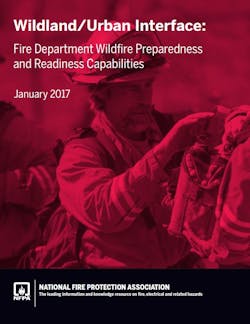The National Fire Protection Association (NFPA) has released a report detailing preparedness for wildland-urban interface (WUI) firefighting.
The “Wildland-Urban Interface: Fire Department Wildfire Preparedness and Readiness Capabilities" report was compiled from feedback gathered from dozens of fire officers who responded to a major wildland fire in the last five years.
The report recommends changes in training, improvements for firefighter safety and fitness. It also looks at the need to interact with the public about the dangers of fires in the WUI environment.
Findings from the 75-page report include:
- A number of departments made thoughtful choices about apparatus that could be used for a variety of purposes and about strategic dispatching to maximize the effectiveness of available resources.
- Versatility in radio technology is critical for departments responding to wildland/WUI fires, but costs can be prohibitive.
- When communicating with the public, all departments reported to use traditional methods.
- Efforts to prevent and mitigate fire in the wildland. WUI generally require communication and cooperation among fire personnel and local residents, businesses, and political leaders.
- Fire departments often work with other local government agencies to design and implement strategic mitigation plans.
Several areas that need improvement involving training were identified, including:
- The need to transition from traditional training practices which emphasized structural fire training.
- Career firefighters tend to receive wildland training more so than volunteer firefighters.
- Inconsistent adoption of Wildland/WUI fire training, with local and regional variations in the level and adequacy of training.
- Firefighter fitness levels that may not always be adequate for the rigors of wildland/WUI fire events.
Some of the best practices recommended in the report include:
- Have a cache supply of PPE and shelters that can be taken to the scene of fire incidents for back-up.
- Utilize Type 3 hybrid or Type 6 engines on responses to fire incidents located in wildland-urban interfaces.
- Have radios with analog (VHF) compatibility available for responding to calls in hilly or mountainous terrain.
- Require NWCG minimum wildland firefighter training (IS-700: A National Incident Management System (NIMS) Introduction; I-100 Introduction to the Incident Command System (ICS), S-130: Firefighter Training, including L-180: Human Factors in the Wildland Fire Service, S-190: An Introduction to Wildland Fire Behavior)
- Apply for grants to cover the costs of basic or advanced wildland training courses.
- Require a certain level of health and physical fitness (e.g., arduous/moderate pack test or physical exams that include EKG treadmill stress test) for all fire personnel serving jurisdictions with WUI areas.
- Allow for agility in resource movement and allocation as needed for changing fire behavior, direction and rate of spread, wind speeds, and other weather conditions.
- Use advanced software on smartphones, tablets, or other computers as a mapping platform to implement response attacks, draw fire perimeters, and locate resources and response teams.
- Streamline homeowner access to information about wildfire threat, prevention, and mitigation (e.g., through a website, during home assessments, comprehensive newsletter).
- Encourage the adoption and enforcement of appropriate WUI codes and ordinances.
This is the final report from a two-part series that looks at preparedness. The first report, Phase One, was published in 2015.
According to the U.S. Fire Administration, 116 firefighters have died in the line-of-duty during wildland incidents over the last 10 years.






